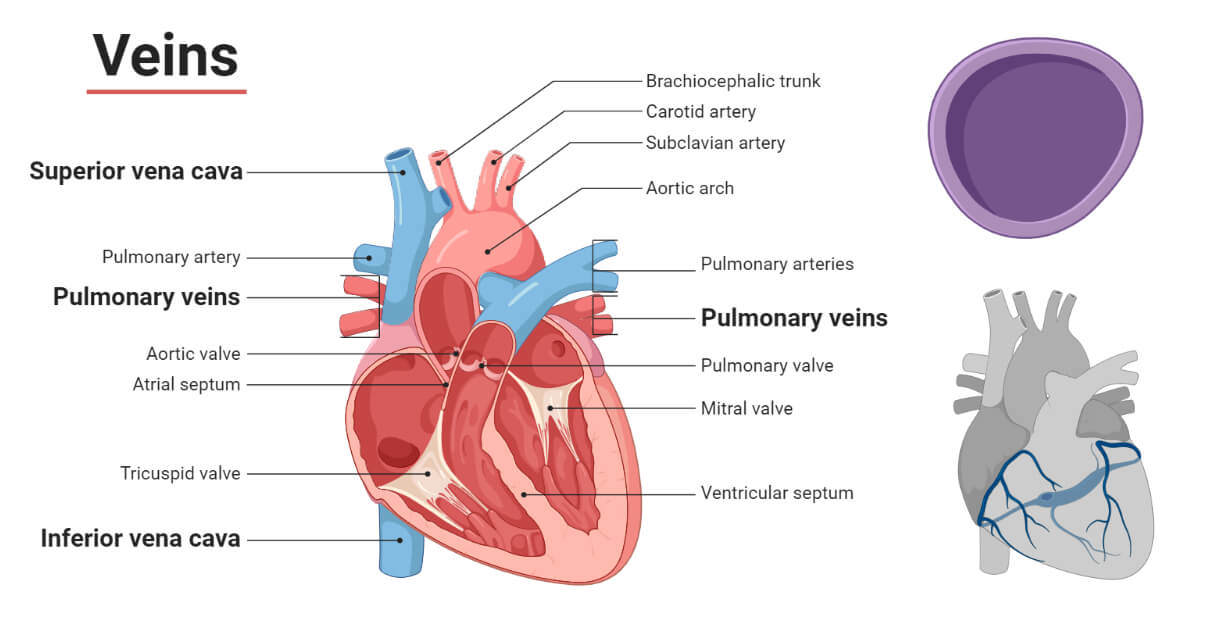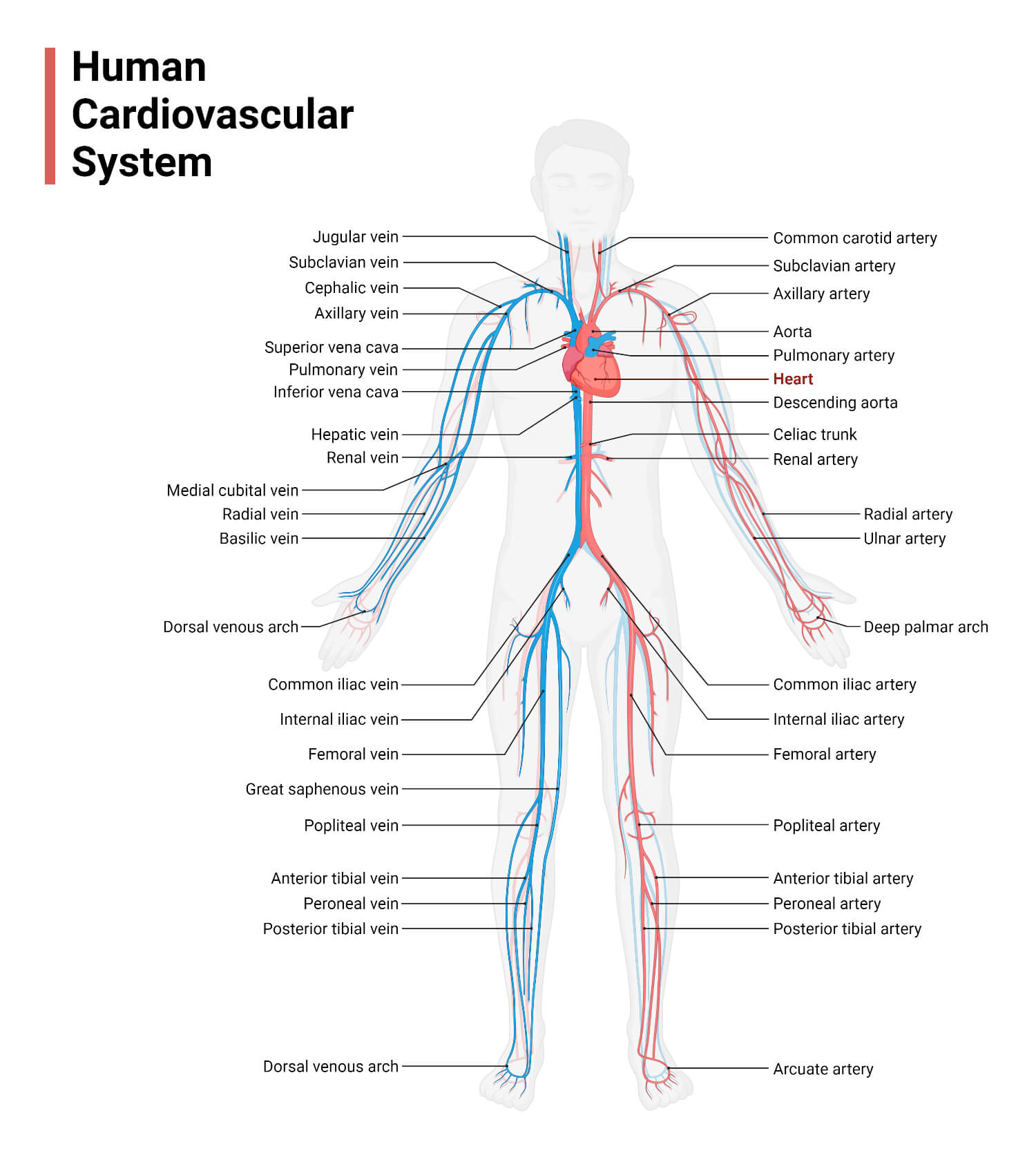Veins are the blood vessels that collect the deoxygenated blood from the various tissues and organs of the body and transport it back to the heart. The blood vessels that carry blood toward the heart are veins.

- All veins carry the deoxygenated blood except the pulmonary veins and the umbilical veins. The pulmonary veins carry the oxygenated blood from the lungs to the left atrium for circulation. The umbilical veins carry the oxygenated blood from the placenta to the growing fetus. The umbilical veins are present only in the growing fetus. The other veins that carry the deoxygenated blood are called the systemic veins.
- Systemic veins collect the deoxygenated blood from capillaries and ascend the blood back to the heart at lower pressure of about 8 to 10 mm of Hg; hence it needs valves, an elastic muscular structure to check the backflow of blood.
- Connected to the capillaries, the veins start as small finer tubules of about 8 to 100 μm in diameter, called the venules. The veins that are connected directly to the capillaries are called the post–capillary venules. Several venules merge forming a smaller vein. Different small veins unite forming larger veins that finally connect to form two major veins called the vena cava; the superior vena cava and the inferior vena cava. The vena cava drains the deoxygenated blood back into the heart at the right atrium.
- Many superficial veins are seen as bluish to purple-colored veins on the surface of our body. These are the sites from where blood is mainly taken for blood tests, blood cultures, or other general medical needs.
Interesting Science Videos
Structure of Veins
Veins are thin-walled valves containing blood vessels. Anatomically, veins have the same three layered walls as arteries that are the tunica externa, the tunica media, and the tunica intima; however, they have considerably lesser amounts of smooth muscles making them thinner than the walls of the arteries. This thinner wall makes the veins more flexible and allows the veins to hold nearly 70% of total blood at any time. The veins carry the blood at very low pressure so they are equipped with venous valves that keep the blood flowing towards the heart by checking the backflow.
1. Tunica Externa/Tunica Adventitia
It is the outermost layer primarily made of connective tissues mainly with collagen fibers providing physical strength and elasticity to the veins.
2. Tunica Media
It is the middle layer composed of connective tissue with elastic fibers and transverse layers of muscle fibers. The smooth muscle cells present in this layer help to regulate the diameter of veins.
3. Tunica Intima
It is the innermost smooth layer made from endothelial cells providing a smooth surface for easy flow of the blood inside the veins.
Types of Veins
Based on the location, they are classified into two types, the superficial veins, and the deep veins.
- Superficial Veins
The veins that lie closer to the body surface underneath the skin are called the superficial veins. These veins are often visible as bluish-to-purple-colored veins. Besides blood transportation, they play an important role in regulating the body temperature. These veins carry a lesser amount of blood in our bodies. Some common and visible superficial veins are externa jugular veins, cephalic veins, cubital veins, basilica veins, etc.
- Deep Veins
The veins that are located deeper within the body are called the deep veins. These veins are not visible from the outside and are often paired with arteries of the same name. These veins carry a major portion of venous blood. Some common deep veins are internal jugular veins, brachial veins, subclavian veins, femoral veins, etc.
Based on the types of blood they carry and the location of delivery, veins can be classified into two types, viz. the pulmonary veins and the systemic veins.
- Systemic Veins
These veins collect and carry the deoxygenated blood from all over the body to the right atrium.
- Pulmonary Veins
These veins carry the oxygenated blood from the lungs to the left atrium. There are four major pulmonary veins – two emerging from each lung.

Some major veins of our body are summarized in the following table.
| The Major Vena Cava | ||
| The Superior Vena Cava | The Inferior Vena Cava | |
| Major Veins Draining into each vena cava | Radial and ulnar veins Cephalic vein Basilic vein Median cubital vein Subclavian vein Vertebral vein Internal jugular vein Brachiocephalic veins Azygos vein | Tibial veins Great saphenous veins Common iliac vein Gonadal vein Renal veins Hepatic portal vein Hepatic vein |
Functions of Veins
- Systemic veins collect the deoxygenated blood from every tissue and organ of our body and transport it back to the heart for reoxygenation and re-circulation.
- Pulmonary veins carry the re-oxygenated blood from the lungs to the heart for re-circulation.
- Superficial veins also help in decreasing body temperature when it gets hot.
Veins and Diseases
Diseases or infirmities affecting the veins and impairing their normal functions are called venous diseases. Veins suffer from a wide range of medical conditions, including infectious and non-infectious diseases. Some of the most common venous diseases are summarized below.
| Disease | Introduction |
| Varicose Veins | Enlarged, twisted veins (commonly in legs) |
| Deep Vein Thrombosis (DVT) | Condition when blood clot forms in deep veins affecting blood circulation. |
| Chronic Venous Insufficiency (CVI) | Condition when the veins in the legs can’t function properly and the venous blood in the legs can’t return to the heart. |
| Spider Vein (Telangiectasias) | A small prominent cluster of damaged small veins. |
| Superficial Thrombophlebitis | Inflammation of superficial veins due to the formation of blood clots inside the veins. |
| May-Thurner Syndrome | A condition where the left iliac vein is compressed by the right common iliac artery against the lumbar spine. |
References
- Ross & Wilson Anatomy & Physiology in Health and Illness. 13th ed. Churchill Livingstone Elsevier. ISBN 978-0-7020-7276-5
- Peters, M., Syed, R. K., Katz, M., Moscona, J., Press, C., Nijjar, V., Bisharat, M., & Baldwin, D. (2012). May-Thurner syndrome: A not so uncommon cause of a common condition. Proceedings (Baylor University. Medical Center), 25(3), 231-233. https://doi.org/10.1080/08998280.2012.11928834
- Sandean DP, Winters R. Spider Veins. [Updated 2023 Jan 3]. In: StatPearls [Internet]. Treasure Island (FL): StatPearls Publishing; 2023 Jan-. Available from: https://www.ncbi.nlm.nih.gov/books/NBK563218/
- https://my.clevelandclinic.org/health/diseases/17213-may-thurner-syndrome
- Venous System: Vein Anatomy and Function, Vein Types, Conditions (healthline.com)
- Veins: Anatomy and Function (clevelandclinic.org)
- Britannica, The Editors of Encyclopaedia. “vein”. Encyclopedia Britannica, 17 Apr. 2023, https://www.britannica.com/science/vein-blood-vessel. Accessed 30 May 2023.
- Veins – Anatomy, Function, and More (verywellhealth.com)
- Structure and function of blood vessels – Structure and function of arteries, capillaries and veins – Higher Human Biology Revision – BBC Bitesize
- Blood Vessels: Types, Anatomy, Function & Conditions (clevelandclinic.org)
- Vein Function & Structure | Anatomy & Types of Veins – Video & Lesson Transcript | Study.com
- Superficial vein. (2022, December 7). In Wikipedia. https://en.wikipedia.org/wiki/Superficial_vein
- https://www.hopkinsmedicine.org/health/conditions-and-diseases/chronic-venous-insufficiency
- https://www.webmd.com/skin-problems-and-treatments/cosmetic-procedures-spider-veins
- Venous Disease: Types, Symptoms & Treatment (clevelandclinic.org)
